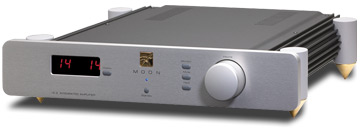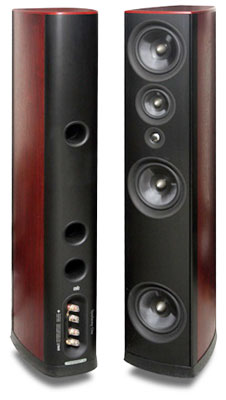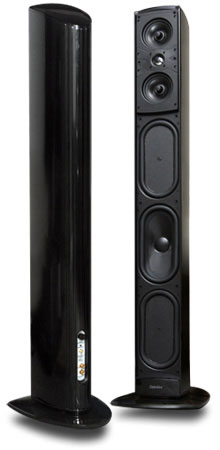April 1, 2010On Reference Equipment
At least once a week, I’m asked by a reader to
recommend an electronic component, a cable, a loudspeaker -- or all three at once. Being
asked such questions is gratifying; it tells me that people are reading my reviews and
take my assessments seriously enough to want my advice. But while that advice is freely
given, it isn’t something I dispense without serious consideration.
I’ve taken a lot of time to assemble my own system,
not least because new review products come along and cause me to defer any purchase a bit
longer by giving me more choices. That was the case with my search for a reference
loudspeaker, which took me about two years to complete. Part of the problem I faced was an
embarrassment of riches: there are so many great speakers being made today that it seemed
an impossible task to choose just one.
When choosing a new component for my system, I do as most
readers do: ask others for advice, scan the market for what’s available, and,
ultimately, rely on my own counsel. In the last, I’m fortunate in having already
reviewed a lot of the products. In addition to those things, I factor in the
company’s reputation, and the expertise of the people who designed and made the
product.
Certain industries attract romantic dreamers -- airlines
and car manufactures come to mind -- who have more capital than business sense. Audio is
no exception. Dozens of companies have come and gone in less time than the average product
cycle at such stalwart firms as Bryston, Paradigm, and McIntosh. Keeping that in mind, I
tend to shy away from companies whose product lines have little or no depth, that are very
new, or that seem to be selling their products at prices that can lead only to financial
ruin. After all, bankrupt companies don’t honor warranties -- and they make selling
their gear in the used market that much more difficult.
 The first reference component I
bought was a Simaudio Moon i5.3 integrated amplifier. I purchased the Moon early in my
reviewing career, before I’d heard many of its competitors. But today, several years
later, I’ve yet to hear another integrated amp in my price range to make me regret
that decision. So while it was a decision made somewhat in the dark, it has turned out to
be a good one. The first reference component I
bought was a Simaudio Moon i5.3 integrated amplifier. I purchased the Moon early in my
reviewing career, before I’d heard many of its competitors. But today, several years
later, I’ve yet to hear another integrated amp in my price range to make me regret
that decision. So while it was a decision made somewhat in the dark, it has turned out to
be a good one.
While there are many dreamers in the component and speaker
businesses, cable manufacturing is full of them. Because it seems that anyone with a
soldering iron can get into the cable business, I stick with companies that employ physics
and electrical-engineering knowhow to design their products. Can’t-go-wrong companies
include Analysis Plus, Crystal Cable, Supra Cable, and Synergistic Research. One thing
shared by all five of these manufacturers is that they don’t employ hyperbole in
their marketing -- in fact, some do a pretty lousy job of selling themselves. Another
commonality is that each of these companies has contributed to one of my systems: Crystal
Cable Piccolo interconnects and speaker cable, and Synergistic Research Tesla Tricon USB
and T2 and T3 power cables in my main system; Supra Cable speaker cables and power cords
in my home theater; and Analysis Plus in my secondary system.
 When it came to loudspeakers, I had a list
of upper-end and midline products that made it into the playoffs. The most expensive
speaker I considered was Paradigm’s Reference Signature S8 v.3 ($6998 USD; all
speaker prices per pair), a stunning achievement in sound and appearance that would please
even the most tinny ear. Unfortunately, they proved almost twice as expensive as other
high-end contenders, and so were eliminated by financial reality. That left in the running
PSB’s Synchrony One (shown left, $5000) and Imagine T ($2000), Paradigm’s Studio
60 ($1998), and Focus Audio’s Classic FC9 ($1800) and Signature FS8 ($2990). Of
those, I best liked the FC9’s sound, but though the speaker is finished to a very
high standard, I don’t much like the colors it comes in. Petty, perhaps, but I do
have to look at the things. When it came to loudspeakers, I had a list
of upper-end and midline products that made it into the playoffs. The most expensive
speaker I considered was Paradigm’s Reference Signature S8 v.3 ($6998 USD; all
speaker prices per pair), a stunning achievement in sound and appearance that would please
even the most tinny ear. Unfortunately, they proved almost twice as expensive as other
high-end contenders, and so were eliminated by financial reality. That left in the running
PSB’s Synchrony One (shown left, $5000) and Imagine T ($2000), Paradigm’s Studio
60 ($1998), and Focus Audio’s Classic FC9 ($1800) and Signature FS8 ($2990). Of
those, I best liked the FC9’s sound, but though the speaker is finished to a very
high standard, I don’t much like the colors it comes in. Petty, perhaps, but I do
have to look at the things.
Each of the remaining speakers had a strike against it: I
loved the PSB Synchrony One’s bass and mids, but am no fan of its tweeter; the
Imagine T’s tweeter I like, but the finish is a lot like the Focus FC9’s. The
Focus FS8 is terrific on most fronts, but I wish it had the FC9’s tweeter setup. The
Paradigm Studio 60 is also excellent, but I thought I wouldn’t be able to listen to
it without pining for the S8. So with speaker selection going nowhere fast, I decided to
stop trying to pick one. That worked wonders -- within a week, I’d rediscovered a
speaker that had escaped my list.
 What I realized was that while I’d
heard a lot of terrific speakers over the last couple of years, only two had stood out as
having significant "wow" factor. Interestingly, neither was a speaker I’d
reviewed, but both were present in publisher Doug Schneider’s listening room. I
always know when Doug’s on to something special -- he asks me to come over and listen
to some unspecified component. Twice he’s actually blacked out the room to prevent
visual bias, and to surprise me all the more. One of those blackouts involved perhaps the
best-sounding little speaker ever, the Dynaudio
Excite X12 ($1200). A great speaker it indeed is, but it was way too small for my
needs. The other was the Definitive Technology Mythos STS (shown right, $2998). What I realized was that while I’d
heard a lot of terrific speakers over the last couple of years, only two had stood out as
having significant "wow" factor. Interestingly, neither was a speaker I’d
reviewed, but both were present in publisher Doug Schneider’s listening room. I
always know when Doug’s on to something special -- he asks me to come over and listen
to some unspecified component. Twice he’s actually blacked out the room to prevent
visual bias, and to surprise me all the more. One of those blackouts involved perhaps the
best-sounding little speaker ever, the Dynaudio
Excite X12 ($1200). A great speaker it indeed is, but it was way too small for my
needs. The other was the Definitive Technology Mythos STS (shown right, $2998).
The Mythos STS had already been reviewed by our Roger
Kanno, and Doug had it in for measurements. When I got the call to come over and hear
something "really good," I made a beeline for Doug’s listening room. What I
heard was a beautiful, clean midrange, sparking and refined highs, and deep, tight,
powerful bass. Was I surprised when the lights came up and I was staring at a
"lifestyle" speaker! I soon learned that one of speakerdom’s top engineers
had designed the Mythos line, and was most interested to hear that one of the world’s
greatest-ever speaker designers had looked over the STS and pronounced himself impressed.
Then, amazingly, I forgot all about the Mythos STS --
I’m not sure why. But later, in a real "Well, duh!" moment, it came back to
me, and it was the obvious choice to fulfill my needs. After consulting with Roger, who
felt that the larger Mythos ST ($3998) would better suit my big listening room, I went out
and bought a pair. At long last I have a reference loudspeaker, and I love it.
So ends one journey, at least for the moment. Now all I
need is a D/A converter to complete my system -- but with USB 3.0 coming out, I think that
decision, too, might end up being long deferred. Who knows what its high data rate might
do for sound? In the meantime, maybe a more powerful integrated amp would be a nice idea .
. .
. . . Colin Smith
editor@goodsound.com
|















